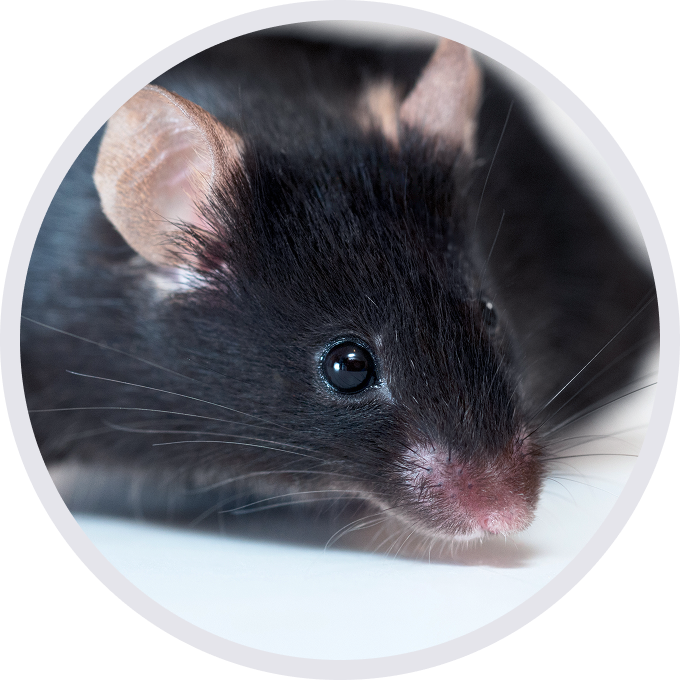
C57BL/6-Cd3etm1(CD3E)Bcgen Cd3dtm1(CD3D)Bcgen Cd3gtm1(CD3G)Bcgen B2mtm2(B2M/HLA-A2.1/H2-D)Bcgen/Bcgen • 112756

| Product name | B-hCD3EDG/HLA-A2.1 mice |
|---|---|
| Catalog number | 112756 |
| Strain name | C57BL/6-Cd3etm1(CD3E)Bcgen Cd3dtm1(CD3D)Bcgen Cd3gtm1(CD3G)Bcgen B2mtm2(B2M/HLA-A2.1/H2-D)Bcgen/Bcgen |
| Strain background | C57BL/6 |
| NCBI gene ID | 3105,915,916,917 (Human) |
| Aliases | CD3-DELTA; IMD19; T3D; CD3-GAMMA; IMD17; T3G; HLAA; IMD18; T3E; TCRE; TCRE; CD3-DELTA; T3D; CD3-GAMMA; T3G; HLAA |
Gene targeting strategy for B-hCD3EDG/HLA-A2.1 mice. The chimeric human CD3EDG was expressed, while mouse Cd3edg were knocked out. The B2M gene (Exon1 to Exon3) of mouse were replaced by the sequence encompassing the human B2M CDS and HLA-A*0201 gene that included leader sequence, α1 and α2 domains ligated to a fragment of the murine H-2Db gene containing the α3, transmembrane and cytoplasmic domains.
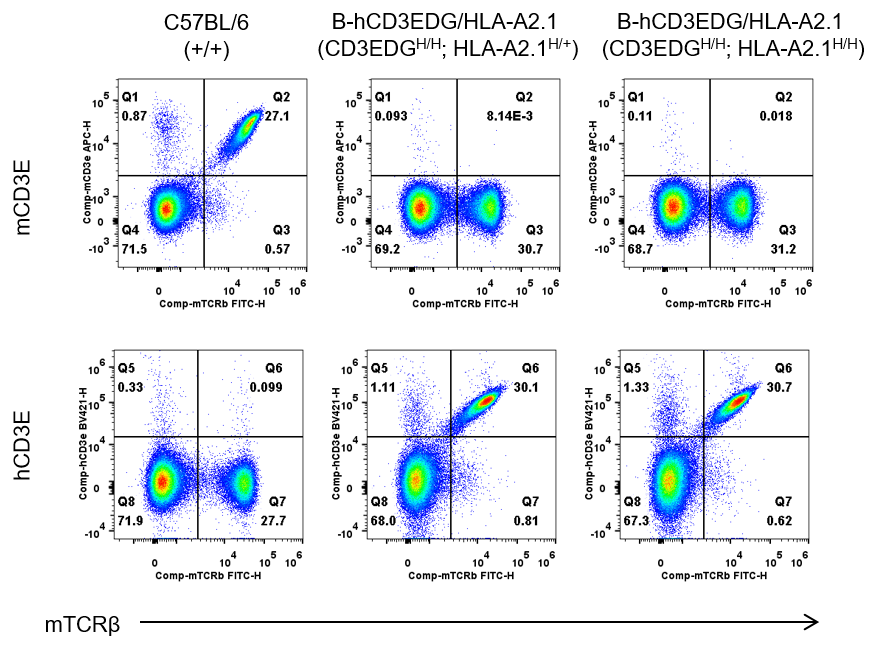
Strain specific CD3E expression analysis in wild-type C57BL/6 mice and humanized B-hCD3EDG/HLA-A2.1 mice by flow cytometry. Splenocytes were collected from wild-type C57BL/6 mice and B-hCD3EDG/HLA-A2.1 mice, and analyzed by flow cytometry. Mouse CD3E was only detectable in wild-type C57BL/6 mice (+/+). Human CD3E was detectable in B-hCD3EDG/HLA-A2.1 mice (CD3EDGH/H; HLA-A2.1H/+) and B-hCD3EDG/HLA-A2.1 mice (CD3EDGH/H; HLA-A2.1H/H) , but not in wild-type C57BL/6 mice (+/+).
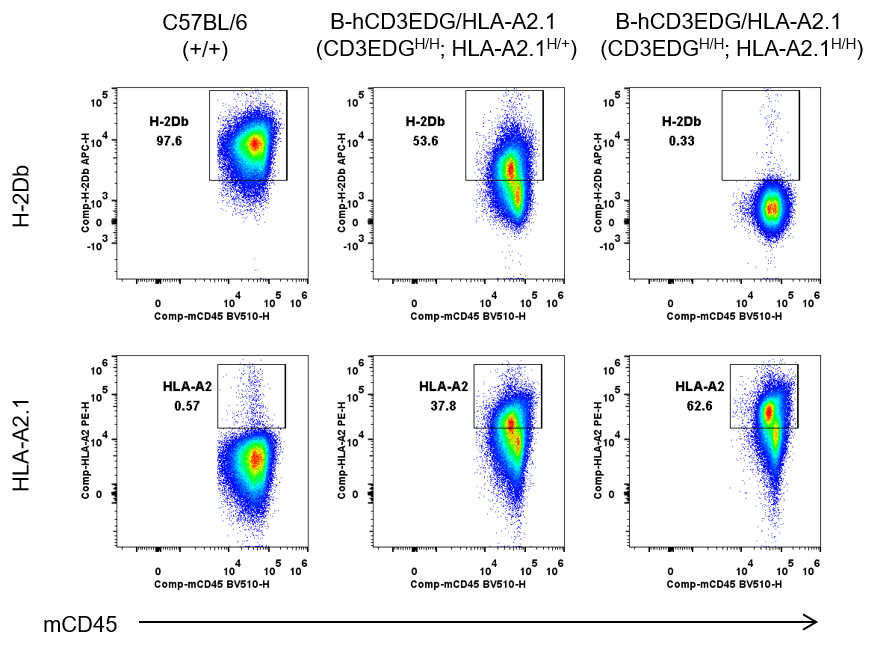
Strain specific HLA expression analysis in wild-type C57BL/6 mice and humanized B-hCD3EDG/HLA-A2.1 mice by flow cytometry. Splenocytes were collected from wild-type C57BL/6 mice and B-hCD3EDG/HLA-A2.1 mice, and analyzed by flow cytometry. Mouse H-2Db was detectable in wild-type C57BL/6 mice (+/+) and B-hCD3EDG/HLA-A2.1 (CD3EDGH/H; HLA-A2.1H/+). Human HLA-A2.1 was detectable in B-hCD3EDG/HLA-A2.1 (CD3EDGH/H; HLA-A2.1H/+) and B-hCD3EDG/HLA-A2.1 (CD3EDGH/H; HLA-A2.1H/H), but not in wild-type C57BL/6 mice (+/+).
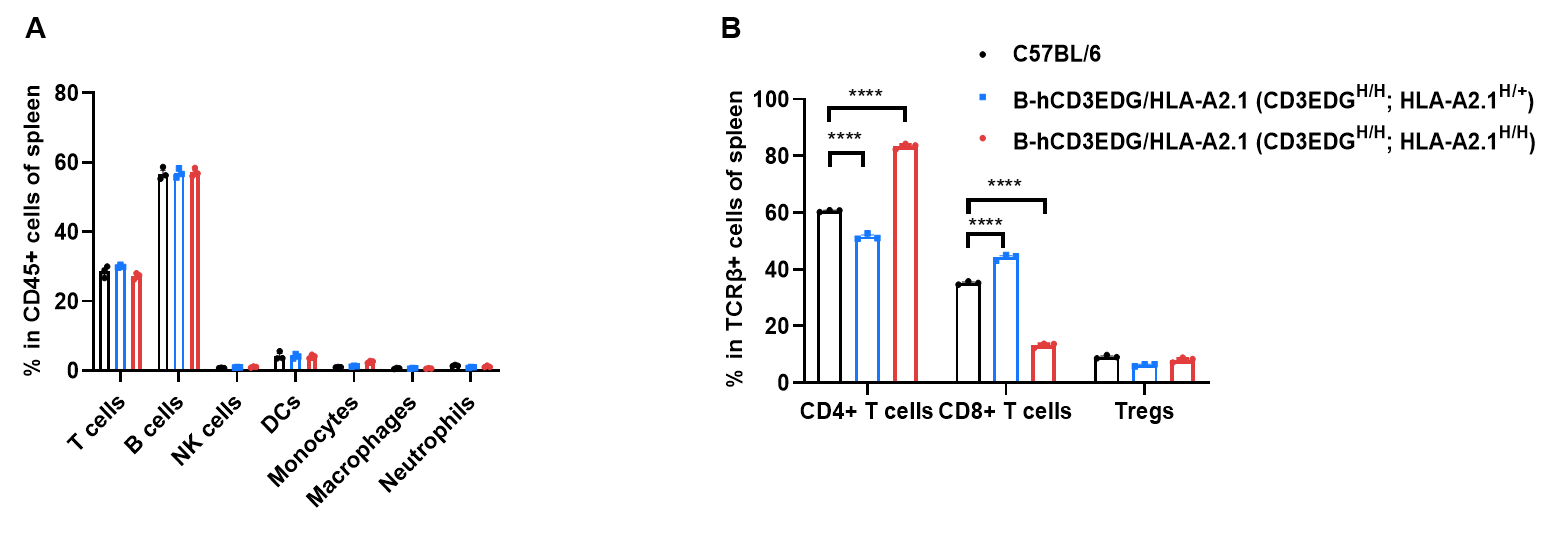
Frequency of leukocyte subpopulations in spleen by flow cytometry. Splenocytes were isolated from wild-type C57BL/6 mice and homozygous B-hCD3EDG/HLA-A2.1 mice (n=3, 7-week-old). A. Flow cytometry analysis of the splenocytes was performed to assess the frequency of leukocyte subpopulations. B. Frequency of T cell subpopulations. Frequencies of T cells, B cells, NK cells, dendritic cells, neutrophils, monocytes and macrophages in B-hCD3EDG/HLA-A2.1 mice were similar to those in the C57BL/6 mice. Compared with C57BL/6 mice, the frequency of CD4+ T cells and CD8+ T cells changed in B-hCD3EDG/HLA-A2.1 mice, especially the frequency of CD8+ T cells in B-hCD3EDG/HLA-A2.1 mice (CD3EDGH/H; HLA-A2.1H/H) decreased significantly. No significant decrease in the frequency of CD8+ T cells was previously observed in B-hCD3EDG mice, so we speculated that the introduction of hB2M-HLA-A2.1-H-2D instead of mouse counterparts may affect the development of CD8+T cells in spleen. Values are expressed as mean ± SEM. *p < 0.05, **p < 0.01, ***p < 0.001, ****p < 0.0001.
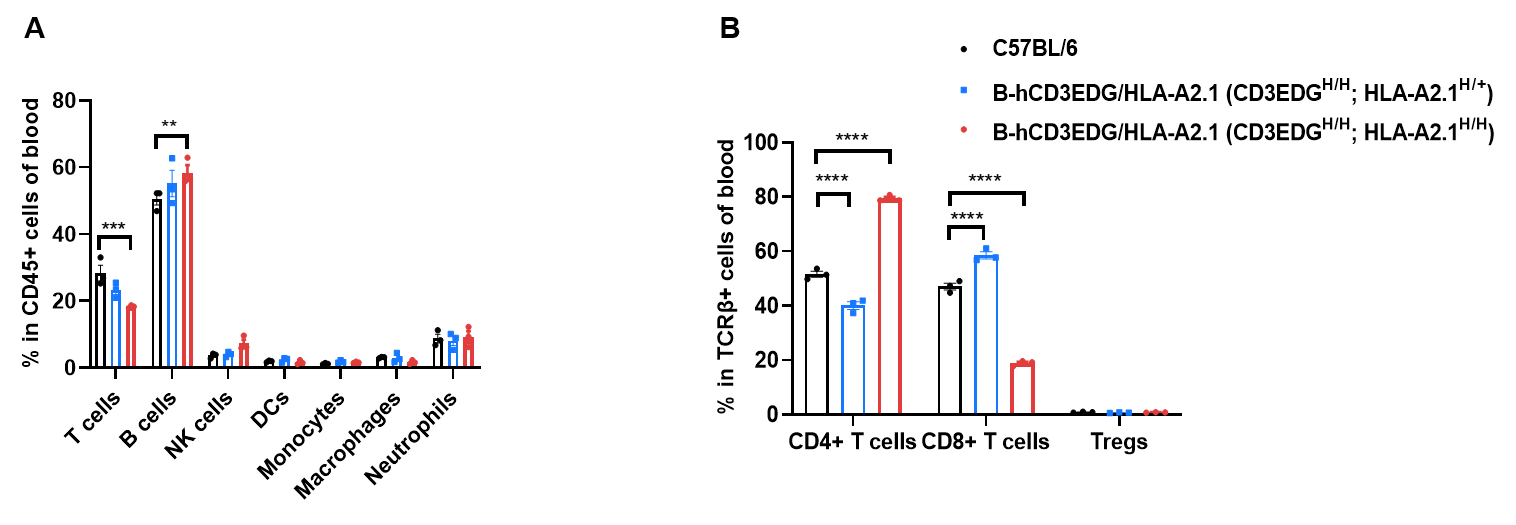
Frequency of leukocyte subpopulations in blood by flow cytometry. Blood cells were isolated from wild-type C57BL/6 mice and homozygous B-hCD3EDG/HLA-A2.1 mice (n=3, 7-week-old). A. Flow cytometry analysis of the blood leukocytes was performed to assess the frequency of leukocyte subpopulations. B. Frequency of T cell subpopulations. Frequencies of NK cells, dendritic cells, neutrophils, monocytes and macrophages in B-hCD3EDG/HLA-A2.1 mice were similar to those in the C57BL/6 mice. Compared with C57BL/6 mice, the frequency of CD4+ T cells and CD8+ T cells changed in B-hCD3EDG/HLA-A2.1 mice, especially the frequency of CD8+ T cells in B-hCD3EDG/HLA-A2.1 mice (CD3EDGH/H; HLA-A2.1H/H) decreased significantly. No significant decrease in the frequency of CD8+ T cells was previously observed in B-hCD3EDG mice, so we speculated that the introduction of hB2M-HLA-A2.1-H-2D instead of mouse counterparts may affect the development of CD8+T cells in blood. Values are expressed as mean ± SEM. *p < 0.05, **p < 0.01, ***p < 0.001, ****p < 0.0001.

Frequency of leukocyte subpopulations in lymph node by flow cytometry. Lymph nodes were isolated from wild-type C57BL/6 mice and homozygous B-hCD3EDG/HLA-A2.1 mice (n=3, 7-week-old). A. Flow cytometry analysis of the leukocytes was performed to assess the frequency of leukocyte subpopulations. B. Frequency of T cell subpopulations. Frequencies of T cells, B cells and NK cells in B-hCD3EDG/HLA-A2.1 mice were similar to those in the C57BL/6 mice. Compared with C57BL/6 mice, the frequency of CD4+ T cells and CD8+ T cells changed in B-hCD3EDG/HLA-A2.1 mice, especially the proportion of CD8+ T cells in B-hCD3EDG/HLA-A2.1 mice (CD3EDGH/H; HLA-A2.1H/H) decreased significantly. No significant decrease in the frequency of CD8+ T cells was previously observed in B-hCD3EDG mice, so we speculated that the introduction of hB2M-HLA-A2.1-H-2D instead of mouse counterparts may affect the development of CD8+T cells in lymph node. Values are expressed as mean ± SEM. *p < 0.05, **p < 0.01, ***p < 0.001, ****p < 0.0001.